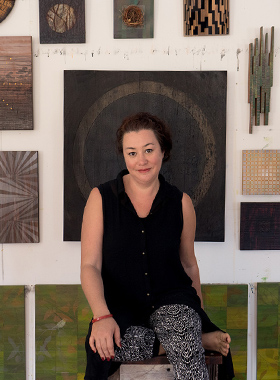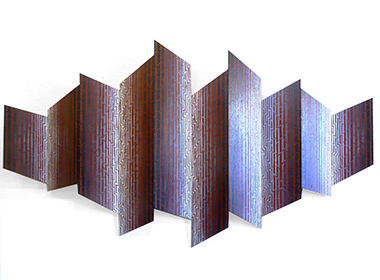 In her element
In her element
Words by Geoff Vivian
A forest path has much in common with a cathedral, Dwellingup artist Monique Tippett says. Every sideways glance reveals another corridor of tree trunks, allowing sunlight to flood downward like stained glass windows shining their lights through rows of columns.
“It’s very spiritual out there for me, like I’m walking down the aisle of a cathedral. It gives me goose bumps,” she says.
To communicate her feeling, Monique started the painting Corridors (below) with jarrah panels, painting into the grain with a network of mostly-vertical lines reminiscent of Jarrah and Marri bark textures. She varied the blue lines’ colour, adding increasing and decreasing amounts of white to evoke soft daylight and dark vertical trunks.
Monique freely admits the influence of another forest artist, Howard Taylor. She says she had just enrolled at Dwellingup’s School of Wood when she saw his 2000 Art Gallery of WA exhibition.
“I remember standing in front of his work with my fingernails digging into my palms of my hands thinking ‘this is how I see the environment’,” she says.
 “It did hit a chord with me, and learning how to create artworks out of timber (at the school) I was never really drawn to make functional-type objects. I was always leaning more towards the art side of things and painting.”
“It did hit a chord with me, and learning how to create artworks out of timber (at the school) I was never really drawn to make functional-type objects. I was always leaning more towards the art side of things and painting.”
During the two-year Diploma of Art course she learned to design and make pieces of fine furniture. She also used pyrography (drawing on wood with a hot wire) and carved into wood with a rotary carver to create texture.
“The rotary carver is like a dentist drill, it takes away the timber,” she says. “I was doing a lot of that and it was very time consuming. I made a conscious effort to try and stop, just to experiment with colour a lot more. It was very woody and then I moved into applying more colour onto the timber. I started doing larger artworks on the wall.
“The grain is very important,” she says. “I love seeing all the stretch marks and grain under there and that’s why I’m using inks so you can actually see the underlying grain. As you are moving past it the light catches and hits on the grain and that really connects me to the forest.”
She also likes to paint with synthetic polymers, lacquers and automotive paint.
 “I will put down a gloss over the top of the matte with some pearl paint in it,” she says. “As you move past it the light catches on the pearl flecks in there.”
“I will put down a gloss over the top of the matte with some pearl paint in it,” she says. “As you move past it the light catches on the pearl flecks in there.”
Her process almost always starts with a walk in the forest, where she says the change of season with its colours and textures compels her to get to work.
“It’s a bit like a drug for me, I have to start it, I have to finish it, then I have to start another one,” she says.
“I enjoy making small maquettes and studies in wood/paint of my immediate ideas. This gives me snapshots of my creative thought process and feelings of my environment at that time. They often fuse into new artworks later down the track. In the summertime I tend to do a lot of burning using fire and ash.”
She says while working on public art commissions has been a valuable experience, she is keen to spend more time in her studio.
“I’m just looking forward to playing with fire,” she says.

Geoff Vivian, a former studio artist, is a writer and photojournalist who has also spent more than a decade working in community development for local councils and as the manager of the Aboriginal radio station at Halls Creek.